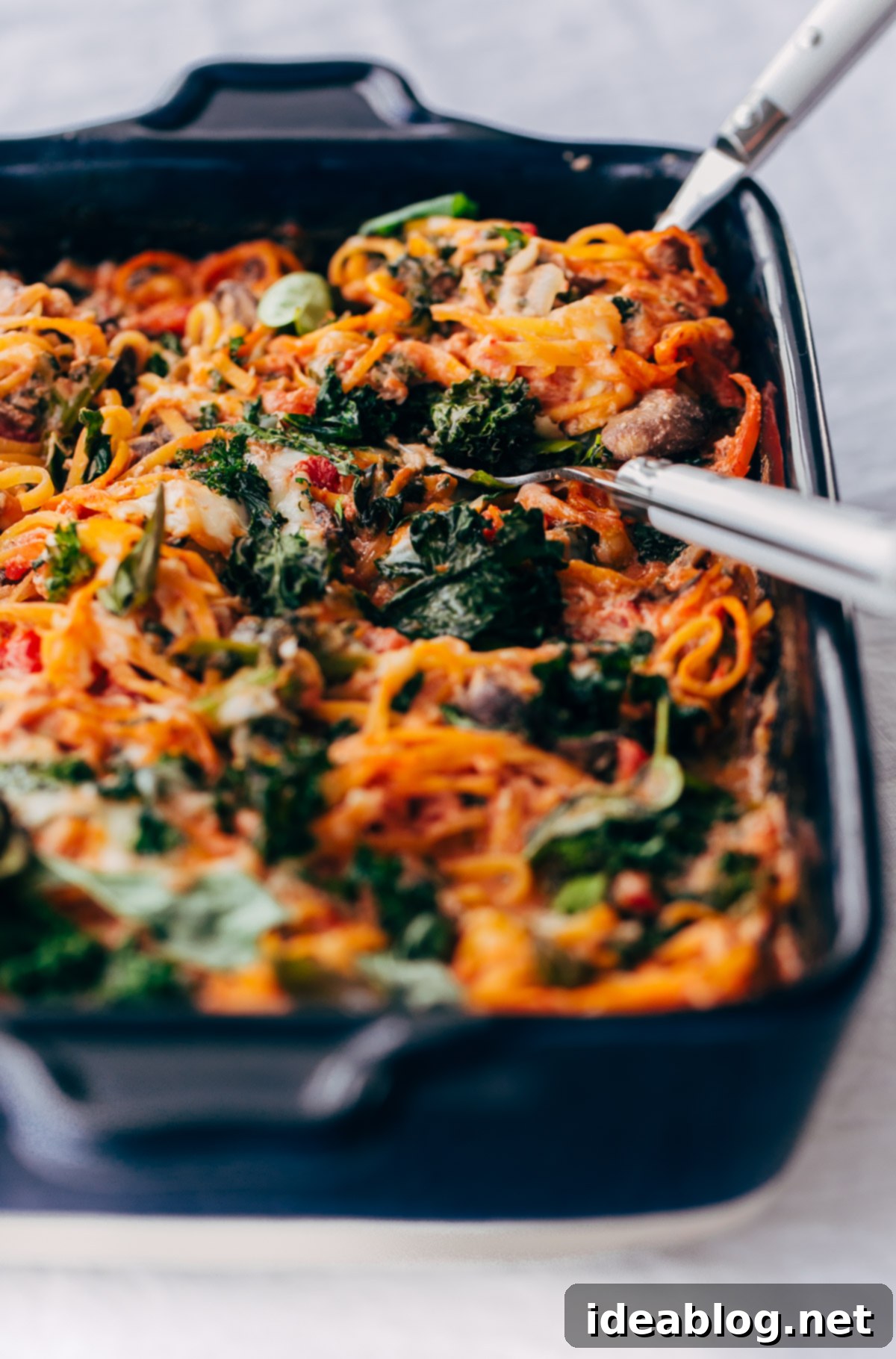Healthy Rutabaga Baked Ziti: A Spiralized Vegetable Noodle Masterpiece
Experience a delightful, spiralized vegetable twist on classic baked ziti, crafted with hearty rutabaga noodles, earthy mushrooms, nutritious kale, a rich and simple tomato sauce, all layered with creamy ricotta and luscious mozzarella cheese. This isn’t just a meal; it’s a culinary revelation that redefines comfort food, proving that healthy can be incredibly satisfying.
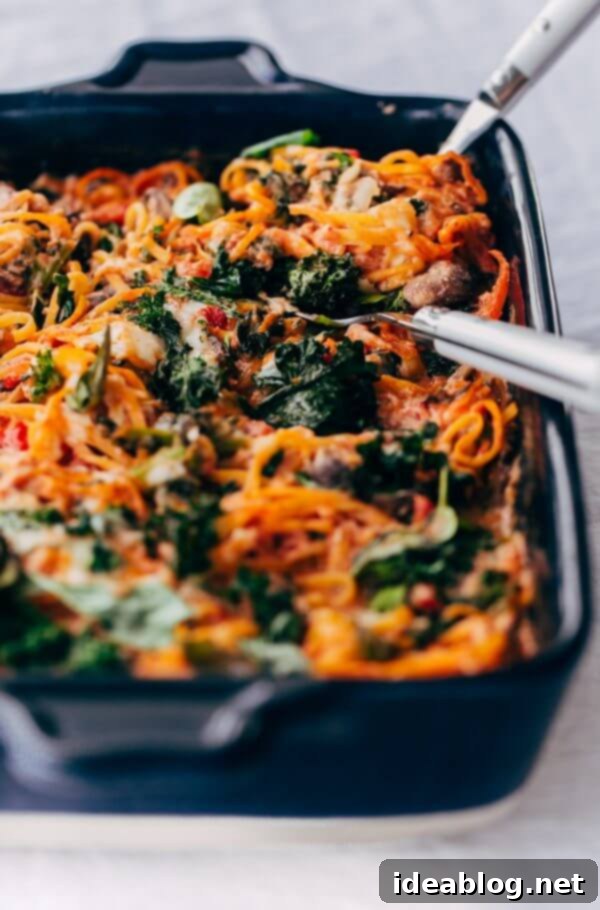
For as long as I can remember, my profound love affair with pasta has been a defining characteristic of my culinary identity. Growing up in a household that proudly embraced its 50% Italian heritage, pasta wasn’t just a dish; it was a fundamental staple, woven into the very fabric of our family meals and cherished traditions. While other kids at school might have been content with peanut butter and jelly sandwiches for lunch, you’d often find me with a container of leftover buttered pasta, generously dusted with freshly grated Parmigiano-Reggiano. My family would absolutely confirm this deep-seated devotion. This enduring love for pasta runs so deep in my veins, almost genetically ingrained, that it’s hard to imagine a meal without it. So, you can perhaps imagine my initial reaction, born from years of unwavering loyalty to traditional pasta, to the concept of “vegetable noodles.” Let’s just say, it was met with a significant amount of skepticism, an undeniable “major side eye” of epic proportions.
Like any true Italian food enthusiast, I approached the idea of replacing traditional pasta with vegetables with considerable doubt. It felt almost sacrilegious, a betrayal of culinary heritage. For this reason, and many others, I’ve always felt a profound sense of kindred spirit with Ali, the brilliant mind behind Inspiralized. She, too, shared this initial skepticism towards veggie noodles. However, her perspective quickly transformed after just one bite of perfectly twirlable zucchini noodles. That moment was a game-changer, opening her eyes to a world of possibilities. What makes Ali’s journey so remarkable is how she took the simple concept of spiralized vegetables and revolutionized it, literally creating her very own inspiralizer tool. She didn’t just embrace this innovative cooking method; she brought everyone, including me, along with her on this exciting culinary adventure, opening up a world of healthy, delicious, and surprisingly hearty possibilities.
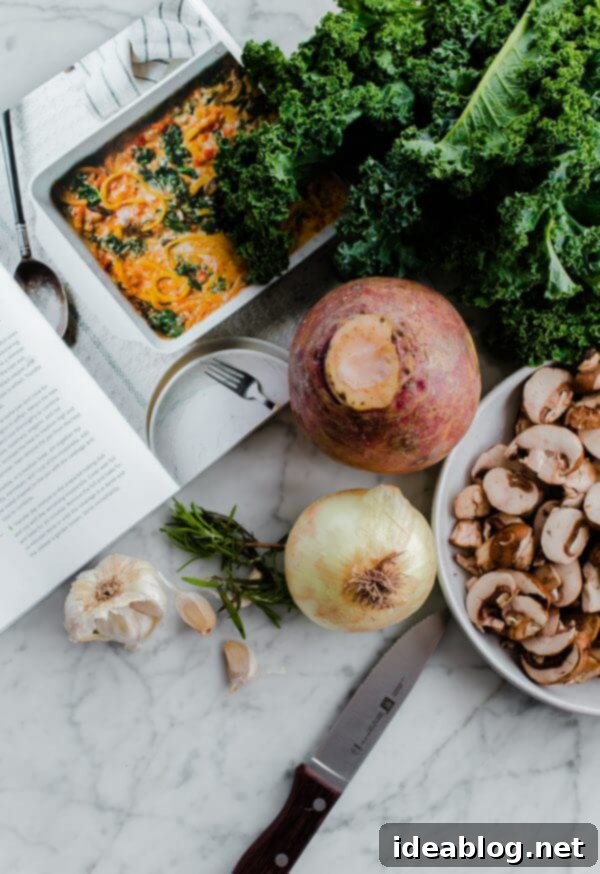
I had the distinct pleasure of meeting and rooming with Ali at a blogging retreat earlier this year. It quickly became clear that she is a true trailblazer in the culinary and digital world. Her dedication and work ethic are truly inspiring, making her one of the hardest-working individuals I’ve had the privilege to meet. Beyond her incredible drive, she possesses an infectious positivity and an encouraging spirit that uplifts everyone around her. It was an honor to witness her passion firsthand and understand the genuine heart she puts into her work, transforming how people approach vegetables.
Today, we’re not just sharing a recipe; we’re celebrating a significant milestone: the release of her newest cookbook, Inspiralize Everything, which launched earlier this week. As its title boldly suggests, Ali’s latest masterpiece is a comprehensive, A-to-Z encyclopedia of spiralizing. It transcends the basic techniques, delving deep into the world of spiralized fruits and vegetables, offering endless creative inspiration for home cooks looking to embrace healthier eating habits. This book doesn’t just skim the surface; it covers every conceivable aspect, guiding you from foundational knowledge to advanced culinary artistry, making spiralizing approachable for all skill levels.
The cookbook boasts an astounding 120 recipes, each one a testament to Ali’s ingenuity and commitment to flavorful, vegetable-forward meals. What’s truly remarkable is how these recipes manage to be incredibly creative while remaining familiar and entirely accessible for cooks of all skill levels. From vibrant salads to comforting main courses, there’s something for everyone. One of the standout features of Inspiralize Everything is its unique organization into twenty-one dedicated chapters, each focusing on a specific vegetable or fruit. These chapter introductions are invaluable, providing a thorough overview of each ingredient – from preparation tips and cutting techniques to detailed nutritional information and fascinating insights into their culinary potential. Even better, most recipes are accompanied by thoughtful substitution ideas, ensuring maximum versatility and adaptability, allowing you to tailor dishes to your preferences or what’s readily available in your pantry.
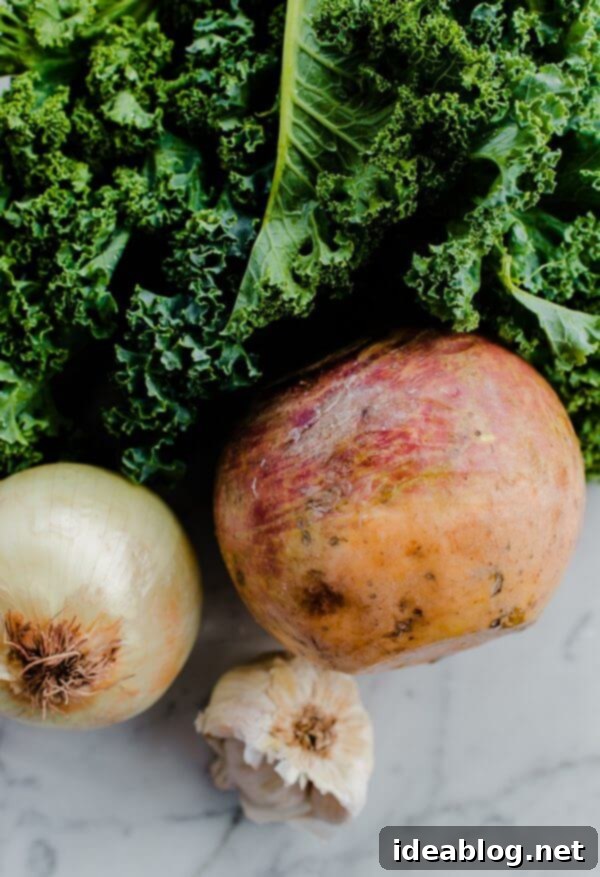
One of the most compelling reasons why I wholeheartedly embraced spiralizing over the past year is its profound ability to encourage me to explore and cook vegetables that I might otherwise overlook at the grocery store or farmer’s market. This aspect is particularly thrilling and refreshing for any vegetable lover, or indeed, anyone aiming to effortlessly incorporate more vegetables into their daily diet. It transforms often-ignored produce into exciting, pasta-like alternatives, adding novelty and nutrition to everyday meals. Beyond the obvious health benefits of increasing vegetable intake, spiralizing offers a fun, creative way to diversify your diet and discover new textures and flavors in familiar dishes.
Rutabaga, for instance, was one of those humble root vegetables I rarely considered or purchased. This often-misunderstood vegetable, also known as a swede or yellow turnip, is believed to be a cross between a turnip and a wild cabbage, with its origins tracing back to Scandinavia or Russia. Raw, it shares a similar firm texture and a slightly peppery, earthy flavor profile with a turnip – so much so that they are often confused in the produce aisle. However, when cooked, the rutabaga undergoes a remarkable transformation, becoming much more delicate, subtly sweet, and wonderfully tender in flavor. As Ali articulates in her cookbook’s rutabaga chapter introduction, this often-underestimated vegetable maintains its structure exceptionally well during cooking. This makes it an ideal, sturdy choice for vegetable noodles, especially in a hearty, baked dish like this ziti with nutrient-rich kale and savory mushrooms. Its robust nature ensures that the noodles hold up beautifully under the rich sauce and cheese, providing a satisfying bite that rivals traditional pasta without becoming mushy.
This Rutabaga Baked Ziti bursts with all my favorite classic Italian flavors, creating a symphony for the palate. The base is a vibrant crushed tomato sauce, seasoned generously with aromatic oregano and rosemary, and given a subtle, warming kick from dried red pepper flakes. Layers of creamy whole-fat ricotta, melted shredded mozzarella, and sharp grated Parmigiano-Reggiano cheese bind everything together, creating that irresistible, gooey, cheesy baked ziti experience we all crave. The strategic addition of earthy, umami-rich cremini mushrooms and tender, slightly bitter curly kale not only introduces delightful textural contrasts but also significantly amplifies the dish’s heartiness and nutritional value, transforming it into a complete, incredibly satisfying, and wholesome meal that feels indulgent yet is packed with goodness.
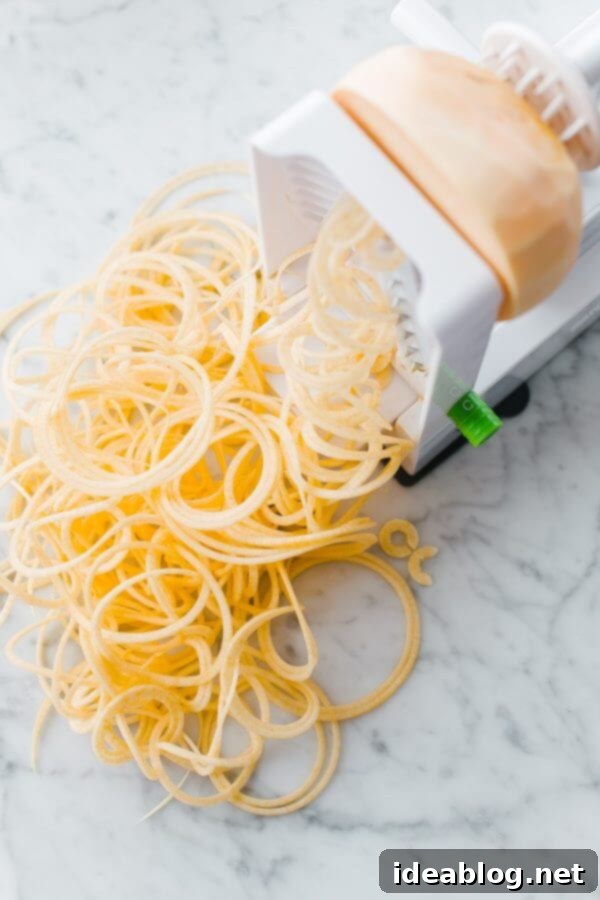
To successfully prepare this recipe and truly enjoy the process, it is absolutely crucial to have a durable and high-quality spiralizer. Rutabagas are notoriously tough vegetables. Their dense, firm flesh can make you genuinely worry about losing a finger if you were to attempt traditional slicing and dicing (yes, they’re even tougher than many winter squashes, which is saying something!). This is precisely why Ali’s dedication to creating a superior tool is so commendable. Her very own Inspiralizer was specifically engineered to effortlessly handle such challenging vegetables, and it has since become one of my most cherished and indispensable kitchen tools. It produced perfectly uniform, beautiful rutabaga noodles with incredible ease – truly ridiculously easy! Beyond its efficiency, spiralizing is also an incredibly fun and engaging activity, making it perfect if you have children or want to involve other family members in the cooking process. It transforms meal preparation into an interactive and enjoyable experience, especially when dealing with tough vegetables that typically require more effort.
Choosing and preparing rutabaga is straightforward once you know a few tricks. Look for rutabagas that feel heavy for their size, with smooth, firm skin and no soft spots or blemishes. Peeling them can be a bit of a workout due to their thick skin, but a sturdy vegetable peeler or even a small paring knife will do the job. Once peeled, they’re ready for the spiralizer. Nutritionally, rutabagas are a powerhouse, boasting an excellent source of Vitamin C, a good source of fiber, and various other essential vitamins and minerals, including potassium, magnesium, and B vitamins. This makes them a fantastic, nutrient-dense choice for any meal, especially when you’re seeking a healthier alternative to traditional pasta.
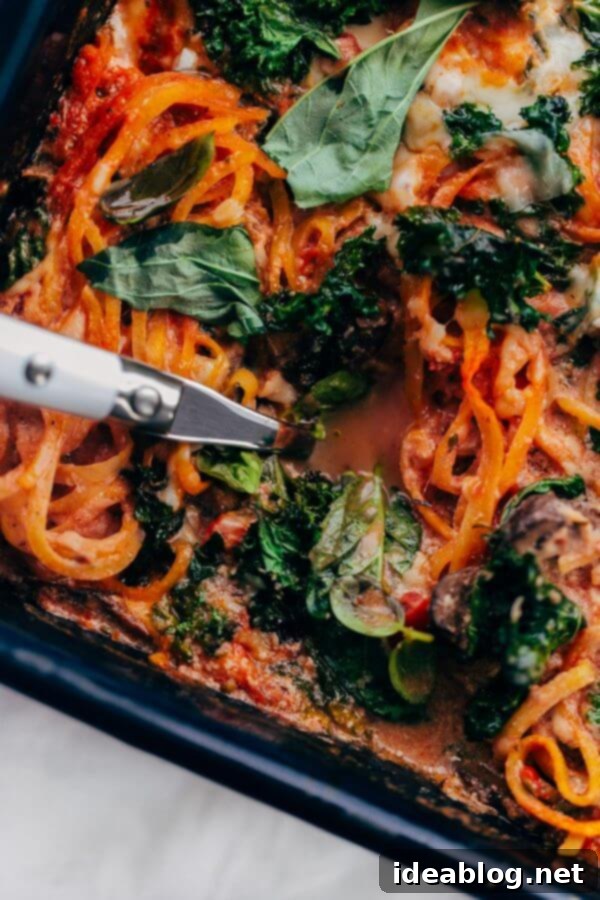
What if you can’t find rutabaga at your local store, or simply wish to try a different variation? Don’t despair! Ali, ever practical and adaptable, suggests sweet potato or regular potato as excellent substitutes in this recipe. Both will yield delicious results, albeit with slightly different flavor profiles and textures. For equivalence, aim for one large or two medium peeled sweet potatoes, or a similar amount of regular potatoes, spiralized in the same manner. This flexibility is just another reason why Inspiralize Everything is such a winner in my kitchen – it empowers you to cook creatively and adapt recipes with what you have on hand. This cookbook isn’t just a collection of recipes; it’s a comprehensive guide to healthier, more imaginative cooking, proving that eating well can be both simple and incredibly flavorful.
When Connor and I first tried this Rutabaga Baked Ziti, we were genuinely amazed by how incredibly filling and satisfying it was. It truly hit all the right notes for comfort food, offering that familiar warmth and richness without the heaviness of traditional pasta. It was so profoundly satisfying that I, someone who rarely passes up a second helping, didn’t even feel the need for more. That’s a rare occurrence for me and a testament to just how complete and hearty this vegetable-based dish truly is. It’s a perfect example of how spiralized vegetables can transform a classic into something new, exciting, and wonderfully wholesome. This dish not only met my expectations for a healthy meal but surpassed them in flavor and fulfilling satisfaction, making it a regular in our dinner rotation.
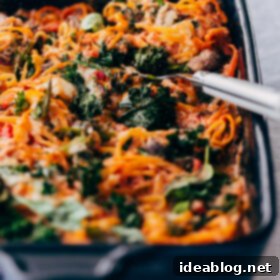
Rutabaga Baked Ziti with Mushrooms and Kale
Pin Recipe
Leave a Review
Save RecipeRecipe Saved!
Ingredients
- cooking spray
- 1 tablespoon (15 mL) extra virgin olive oil
- 2 garlic cloves minced
- 1 small yellow onion diced
- 5 cups curly kale leaves chopped, tough stems removed
- 4 cups sliced cremini (baby bella) mushrooms
- kosher salt to taste
- freshly ground black pepper to taste
- 1 medium rutabaga peeled, spiralized into noodles, and trimmed with scissors to pasta-like length
- 1 (14½-ounce) can crushed tomatoes
- 2 teaspoons fresh chopped or dried rosemary
- 2 teaspoons dried oregano
- ½ teaspoon dried red pepper flakes (adjust to desired spice level)
- 1 cup whole fat ricotta cheese
- 1 cup grated Parmigiano-Reggiano cheese (plus more for serving, if desired)
- 1½ cups shredded mozzarella cheese
- fresh basil leaves for garnishing, chopped
Instructions
-
1. Prepare Baking Dish: Preheat your oven to 400°F (204°C). Lightly coat a medium-sized baking dish (approximately 9×13 inches or similar) with cooking spray, ensuring all surfaces are covered to prevent sticking. Set this aside.
-
2. Sauté Aromatics & Vegetables: Heat the olive oil in a large pot or Dutch oven over medium-high heat. Once the oil begins to shimmer, add the minced garlic and diced onion. Sauté for 3 to 5 minutes, stirring occasionally, until the onion becomes translucent and fragrant. Next, add the chopped curly kale and sliced cremini mushrooms to the pot. Season generously with kosher salt and freshly ground black pepper. Continue to cook for another 5 minutes, or until the kale has fully wilted and the mushrooms have softened, releasing their moisture. Transfer this sautéed vegetable mixture to a separate medium bowl.
-
3. Cook Rutabaga Noodles & Combine with Sauce: Using the same pot (no need to clean), add the trimmed rutabaga noodles. Cook for approximately 5 minutes, stirring frequently, until they start to soften but are still firm and slightly resistant (al dente). If the pan appears too dry, you can add a tablespoon or two of water to help steam the rutabaga and speed up the softening process. Return the reserved kale and mushroom mixture to the pan. Toss thoroughly to combine all the vegetables evenly. Stir in the crushed tomatoes, fresh or dried rosemary, dried oregano, and red pepper flakes. Increase the heat to medium-high and bring the sauce to a gentle simmer. Once simmering, remove the pan from the heat.
-
4. Prepare Cheese Mixture: While the sauce is simmering, prepare your creamy cheese filling. In a separate medium bowl, combine the whole fat ricotta cheese, grated Parmigiano-Reggiano cheese, and 1 cup of the shredded mozzarella cheese. Mix these ingredients thoroughly until well combined and smooth. Add this creamy cheese mixture directly to the pot containing the rutabaga and tomato sauce. Toss gently to ensure the cheese is evenly distributed throughout the vegetable “noodles” and sauce, creating a rich, cohesive mixture.
-
5. Bake to Perfection: Transfer the entire rutabaga and sauce mixture into your prepared baking dish. Spread it evenly across the bottom. Top the dish with the remaining ½ cup of shredded mozzarella cheese, ensuring a generous, even layer for optimal golden browning. Cover the baking dish tightly with aluminum foil and bake for 20 minutes. After 20 minutes, carefully remove the foil and continue baking for another 10 minutes, or until the rutabaga noodles are perfectly tender-crisp (al dente), and the top layer of mozzarella cheese is beautifully melted, bubbly, and golden brown. Serve this hearty and satisfying Rutabaga Baked Ziti immediately, garnished with fresh chopped basil leaves, if desired, for a burst of fresh flavor.
Tips for Success:
- This Rutabaga Baked Ziti is wonderfully hearty and incredibly filling on its own, providing a satisfying meal without additional components. However, if you are a meat lover or seeking to add extra protein and depth of flavor, consider incorporating crumbled Italian sausage or ground turkey. These should be cooked separately until browned and fully cooked before being added to the vegetable and sauce mixture, just prior to transferring everything to the baking dish for its final bake.
- Should rutabaga be unavailable or if you simply wish to try a different variation, sweet potato or regular potato make excellent substitutes. For equivalence, use one large or two medium peeled sweet potatoes, or a similar amount of regular potatoes, spiralized in the same manner. This flexibility allows for delicious adaptations to suit your pantry or dietary preferences.
- To ensure your rutabaga noodles are perfectly al dente and not mushy, keep a close eye on them during the initial sautéing phase. They should soften but retain a slight chew, much like perfectly cooked pasta. Overcooking can lead to a softer texture.
- For an even richer and more complex flavor in your tomato sauce, consider using fire-roasted crushed tomatoes. Their smoky depth will beautifully complement the earthy undertones of the rutabaga.
- Freshly grated cheeses truly make a noticeable difference in both flavor and how beautifully they melt and bind in a baked dish. While pre-shredded works in a pinch, grating your own Parmigiano-Reggiano and mozzarella will significantly elevate the overall taste and texture of the dish.
- Don’t skip trimming the rutabaga noodles with scissors. Spiralized vegetables can sometimes produce very long strands, which are difficult to eat. Trimming them makes the dish much more enjoyable and pasta-like.
Reprinted with permission from Inspiralize Everything by Ali Maffuci (Clarkson Potter, 2016).
